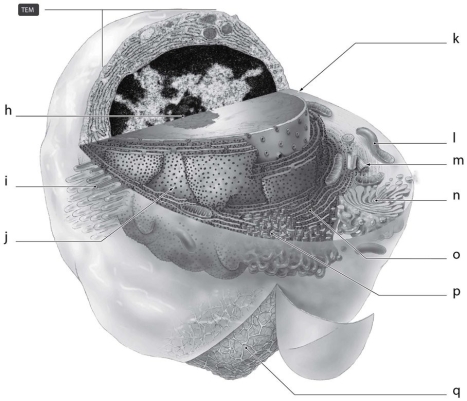Correct Answer

verified
Correct Answer
verified
Short Answer
 The process illustrated in Figure 3.6 occurs in (eukaryotic/bacterial/archaeal) cells.
The process illustrated in Figure 3.6 occurs in (eukaryotic/bacterial/archaeal) cells.
Correct Answer

verified
Correct Answer
verified
True/False
Eukaryotic ribosomes are composed of 50S and 30S subunits.
B) False
Correct Answer

verified
Correct Answer
verified
Multiple Choice
The cytoplasmic membranes of ________ may contain branched hydrocarbons.
A) archaeal cells
B) bacterial cells
C) eukaryotic cells
D) both bacterial and eukaryotic cells
E) archaeal, bacterial, and eukaryotic cells
G) A) and B)
Correct Answer

verified
Correct Answer
verified
Multiple Choice
The cell walls of some ________ are composed of minerals such as calcium carbonate.
A) archaea
B) bacteria
C) algae
D) fungi
E) bacteria and fungi
G) C) and E)
Correct Answer

verified
Correct Answer
verified
True/False
Peroxisomes contain enzymes used to digest nutrients that have been brought into the cell through phagocytosis.
B) False
Correct Answer

verified
Correct Answer
verified
Essay
Compare and contrast archaea and bacteria, with particular attention to the features that lead to their placement in separate taxa.
Correct Answer

verified
Bacterial cell walls are composed of pep...View Answer
Show Answer
Correct Answer
verified
View Answer
Short Answer
The smooth endoplasmic reticulum is the site of (protein/lipid/carbohydrate) synthesis.
Correct Answer

verified
Correct Answer
verified
Multiple Choice
The accumulation of glucose 6-phosphate inside a bacterial cell via phosphorylation of glucose is an example of
A) facilitated diffusion.
B) group translocation.
C) osmosis.
D) plasmolysis.
E) diffusion.
G) B) and C)
Correct Answer

verified
Correct Answer
verified
True/False
 The short structures on the surface of the cell in Figure 3.5 are pili.
The short structures on the surface of the cell in Figure 3.5 are pili.
B) False
Correct Answer

verified
Correct Answer
verified
Essay
Describe how the structure of the bacterial cytoplasmic membrane relates to its function of selective permeability.
Correct Answer

verified
The structure and function of the cytopl...View Answer
Show Answer
Correct Answer
verified
View Answer
Multiple Choice
Using a microscope, you observe an amoeba moving toward a food source. This is an example of
A) reproduction.
B) cellular structure.
C) metabolism.
D) growth.
E) responsiveness.
G) B) and C)
Correct Answer

verified
Correct Answer
verified
Multiple Choice
What types of molecules may NOT need transport proteins to be able to cross cytoplasmic membranes?
A) large molecules
B) ions
C) small hydrophobic molecules
D) small hydrophilic molecules
E) nothing crosses cytoplasmic membranes without transport proteins
G) C) and E)
Correct Answer

verified
Correct Answer
verified
Multiple Choice
Cholesterols are typically found in ________ cytoplasmic membranes.
A) eukaryotic
B) bacterial
C) archaeal
D) prokaryotic
E) both eukaryotic and prokaryotic
G) C) and E)
Correct Answer

verified
Correct Answer
verified
Multiple Choice
Which of the following contribute to the ability of archaea to survive in extreme environments?
A) branched hydrocarbons with ether linkages
B) phospholipids with monounsaturated fatty acids
C) hopanoids
D) glycerols
E) both hopanoids and glycerols
G) A) and D)
Correct Answer

verified
Correct Answer
verified
Multiple Choice
Membrane rafts are found in the cytoplasmic membranes of
A) archaea only.
B) bacteria only.
C) eukaryotes only.
D) both archaea and bacteria.
E) both archaea and eukaryotes.
G) None of the above
Correct Answer

verified
Correct Answer
verified
Multiple Choice
Short, hairlike structures used only by eukaryotic cells for movement are called
A) pili.
B) flagella.
C) fimbriae.
D) pseudopodia.
E) cilia.
G) A) and C)
Correct Answer

verified
Correct Answer
verified
Short Answer
The presence of a cell (wall/membrane) enables bacterial and plant cells to resist the effects of hypotonic solutions.
Correct Answer

verified
Correct Answer
verified
Multiple Choice
 What is the function of the cellular structure indicated by "m" in Figure 3.3?
What is the function of the cellular structure indicated by "m" in Figure 3.3?
A) ATP synthesis
B) protein synthesis
C) synthesis of lipids
D) packaging of materials for export
E) cell movement and mitosis
G) B) and E)
Correct Answer

verified
Correct Answer
verified
Multiple Choice
The endosymbiotic theory does NOT provide an explanation for
A) the two membranes of the nuclear envelope.
B) the presence of ribosomes in mitochondria.
C) the presence of DNA in chloroplasts.
D) the cristae in mitochondria.
E) the double membrane of chloroplasts.
G) D) and E)
Correct Answer

verified
Correct Answer
verified
Showing 21 - 40 of 80
Related Exams